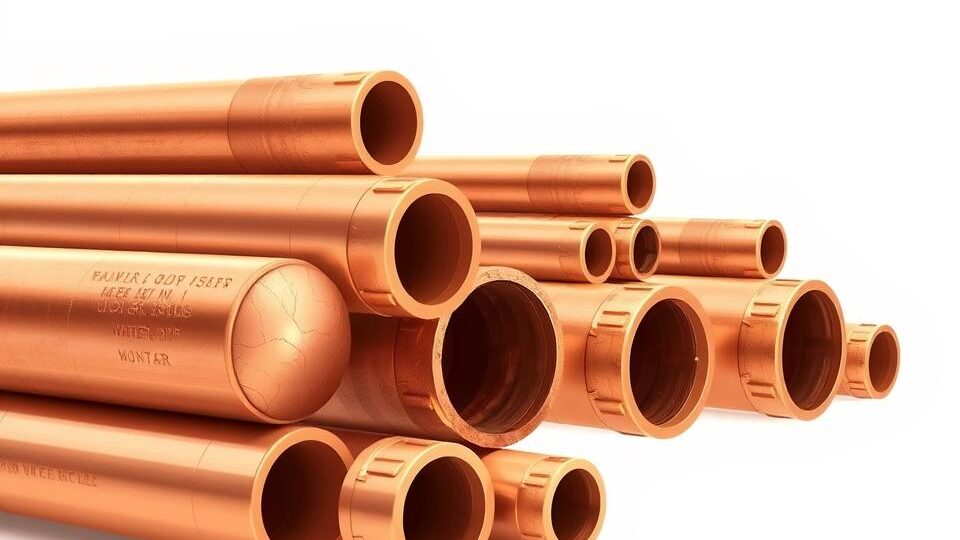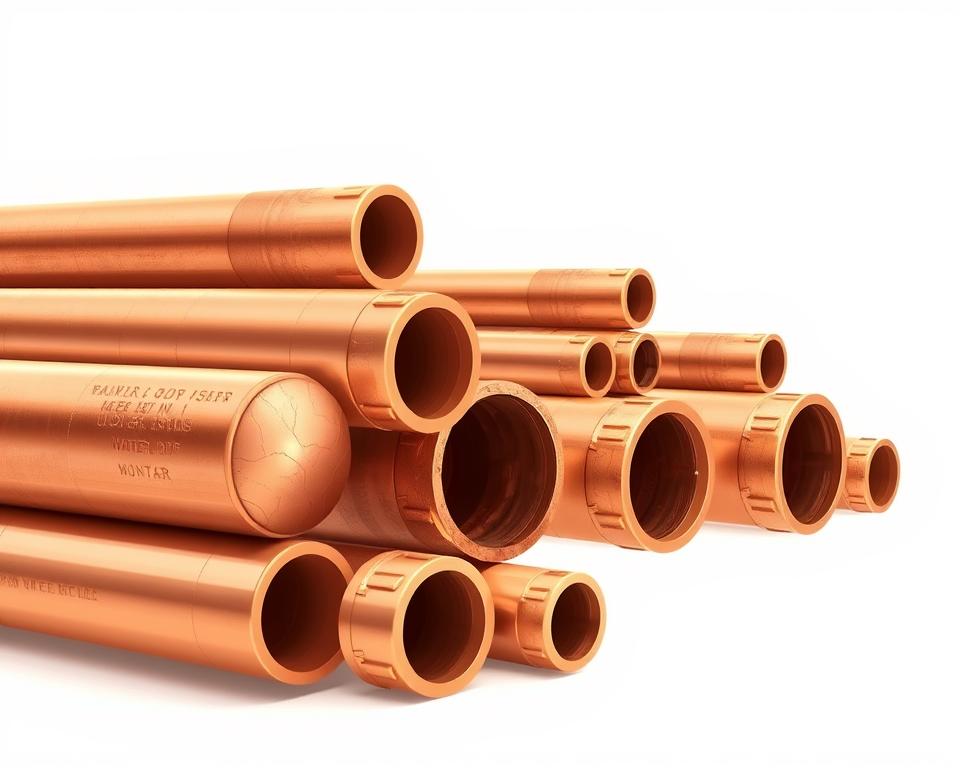
Using Type L Copper Pipe in Natural Gas Applications
Your Guide to Copper Water Line Sizing at Home
Did you realize that almost 30% of household plumbing problems are caused by pipes of the wrong size? Selecting correct sizes guarantees peak water pressure and overall system performance. This guide helps homeowners understand the basics of sizing for residential projects.
Proper sizing depends on factors like flow requirements and wall thickness. Industry-standard 3/8 copper pipe spans diameters from 1/4″ up to 8″, indicated by NPS (Nominal Pipe Size) versus true OD. Installation Parts Supply offers expert guidance to match your home’s needs with compliant solutions.
Copper continues leading the pack because of its strength and ability to resist corrosion. Whether retrofitting your setup or installing from scratch, knowing these principles cuts downtime and avoids costly mishaps.
Central Ideas

- Correct sizing prevents 30% of common plumbing problems
- Diameters typically span 1/4″ to 8″
- NPS labels don’t match real outer diameters
- Right sizing preserves water pressure and performance
- Copper offers durability and corrosion resistance
- Expert advice guarantees compliance
Reasons to Select Copper for Your Plumbing
Durable plumbing depends on material choice—copper leads the way because: Boasting a half-century lifespan and NSF potable-water approval, it’s a go-to for residences. It uniquely blends durability with environmental responsibility.
Durability and Corrosion Resistance
Copper naturally resists rust and chemical damage, outperforming PVC or PEX. Its smooth interior maintains water pressure by reducing friction. Real-world examples show installations lasting decades without leaks.
Installation Parts Supply stocks quality-certified options to match your project needs. While initial costs are higher, the long-term savings from fewer repairs justify the investment.
Bendability and Freeze Safety
In cold climates, copper’s slight expansion during freezing prevents bursts. Such pliability cuts down the danger of expensive freeze harm. Combine with adequate insulation to optimize freeze defense.
Sustainable and Germ-Fighting Properties
Fully recyclable, copper lessens ecological footprint. Antimicrobial action curbs bacterial proliferation to boost water purity. Environmentally minded users find it superior to plastic substitutes.
Understanding Copper Pipe Water Line Sizes and Types
Homeowners often find pipe measurements confusing—here’s how to simplify them. The industry uses Nominal Pipe Size (NPS), which doesn’t match the actual outer dimensions. For example, a 1/2″ NPS has an outer diameter of 0.625″.
Nominal vs. Actual Pipe Dimensions
Nominal sizes act as identifiers, not actual dimensions. Verify the OD itself when buying. Use this quick conversion guide:
- 1/4″ NPS corresponds to 0.375″ OD
- 1/2″ NPS corresponds to 0.625″ OD
- 3/4″ nominal → 0.875″ actual
L vs. M vs. K Copper Pipes
Three copper variants lead in home plumbing. Their wall thickness determines strength and use cases:
- Type L: Light gauge (0.040″ @ 1/2″), perfect for standard homes.
- Type M: Medium-wall (0.050″ for 1/2″), balances cost and durability.
- Type K: Heavy gauge (0.060″ @ 1/2″), ideal under high PSI.
For versatility, Installation Parts Supply favors Type M in most setups. Sizes above 2″ typically call for Type K in irrigation/commercial.
Type L Copper Pipes: Thin-Wall Versatility
DIY enthusiasts benefit from L-type’s superior bendability. A slender wall cuts both heft and expense without sacrificing dependability. Comes both in straight bars and flexible coils for HVAC to DWV work.
Common Applications and Limitations
Best suited to systems under low pressure. Its 0.040″ wall thickness makes it ideal for:
- HVAC refrigerant lines
- Drain-waste-vent (DWV) systems
- Residential water supply (below 80 PSI)
High-pressure? Skip L-type and choose K-type instead. Coils (max 50ft) ease around corners but must be bent cautiously to avoid kinks.
Choosing and Installing L-Type Pipes
Available in sizes 1/4″–8″, most often:
| Form | Max Length | Best For |
|---|---|---|
| Rigid | 20ft | Straight runs |
| Coiled | 50ft | Tight spaces |
Beginners will find rigid lengths, as recommended by Installation Parts Supply, the easiest to cut and solder. When tackling big installations, coils mean fewer joints, saving time and leak hazards.
M-Type Copper Pipes: The Homeowner’s Choice
Moderate cost plus solid performance make M-type a homeowner favorite. A mid-thickness wall manages daily use without breaking the bank. NSF-certified for potable water and gas lines, it’s a safe choice for kitchens, bathrooms, and heating systems.
M-Type Best Applications
This type excels in hot and cold supply lines, maintaining steady water pressure. Rigid 12ft sticks fit straight sections; 100ft coils flex around obstacles. Typical uses cover:
- Drinking water distribution
- Medical gas lines (oxygen, nitrous oxide)
- HVAC refrigerant lines
Thickness vs. Pressure for M-Type
Sits midway between L and K in gauge and strength. With 0.050″ walls, it tolerates up to 150 PSI without failure. Review these benchmarks:
| Type | Wall Thickness (1/2″) | Max Pressure | Best For |
|---|---|---|---|
| L | 0.040″ | 80 PSI | Low-pressure DWV |
| M | 0.050″ | 150 PSI | Residential supply |
| K | 0.060″ | 200 PSI | Irrigation |
Installation Parts Supply keeps M-type stocked across standard diameters. For gas lines, pair with flare fittings to prevent leaks. Leave small expansion joints in hot lines for temperature shifts.
Type K Copper for Tough Applications
Under the toughest conditions, K-type provides exceptional endurance. Heavy walls plus high PSI capacity suit it to industrial or buried lines. It outperforms slimmer options by standing up to crushing and corrosion.
High-Pressure and Irrigation Applications
Where weaker pipes give out, K-type endures. With 0.060″ walls, it tolerates 200 PSI, suitable for:
- Underground irrigation systems
- Commercial HVAC refrigerant lines
- Fire sprinkler networks
For buried lines, Installation Parts Supply recommends 18″ minimum depth. Combine with compression fittings torqued at 25 ft·lb to ensure leak-free performance.
Installation Tips for Rigid vs. Coiled Forms
Choose the right form for your project. Use 12ft rigid lengths for straight lines; 50ft coils for curves. Compare performance:
| Form | Best For | Limitations |
|---|---|---|
| Rigid | High-pressure mains | Requires more fittings |
| Coiled | Trenchless installations | Risk of kinks if bent sharply |
Plan irrigation loops with 10% extra length for expansion. Avoid bending rigid forms without a tube bender—kinks reduce flow efficiency.
Copper Pipe Installation & Maintenance
Correct methods deliver years of drip-free operation. DIYers or professionals alike benefit from mastering these fundamentals. Use these approaches for solid, durable joints.
Connection Options Compared
Choose the right technique based on your project’s needs. Permanent joints use heat or compression, while temporary options allow adjustments. Here’s a quick comparison:
| Method | Pros | Cons | Best For |
|---|---|---|---|
| Soldering | Strong, permanent | Requires skill | Water supply lines |
| Compression | No heat needed | Bulky fittings | Tight spaces |
| Push-Fit | Quick installation | Higher cost | Emergency repairs |
How to Solder Copper Pipes
For a flawless joint, follow these steps:
- Thoroughly clean with emery cloth.
- Coat each piece evenly with flux.
- Heat until the flux bubbles.
- Touch solder to the fittings—capillary action draws it in.
Always wear heat-resistant gloves and work in a ventilated area. Find NSF-approved, lead-free solder at Installation Parts Supply for water systems.
Preventing Leaks and Freezing Damage
Insulate exposed sections in unheated areas like basements. Fit foam sleeves where lines pass exterior walls. To fix minor issues:
- Inspect fittings yearly for green patina indicating leaks.
- Bracket horizontal stretches every 32 inches to stop drooping.
- Use frost-resistant faucets where temperatures drop.
Annual inspections catch minor issues before they escalate. Stash wrenches, cutters, and Teflon tape in your kit for fast repairs.
Final Thoughts on Copper Pipe Selection
A well-planned system lasts decades—let’s wrap up with key takeaways. Choose proper size and type for lasting durability. Keep in mind:
- Type M suits most homes, while K handles heavy-duty jobs
- Right sizing ensures steady pressure and leak prevention
- Frost defense matters where it gets cold
Installation Parts Supply offers expert guidance to simplify choices. Certified solutions with quality warranties keep your plumbing systems running perfectly.
Looking for assistance? Get free sizing charts or book a consultation now. New customers enjoy special discounts—launch your project on the right foot!